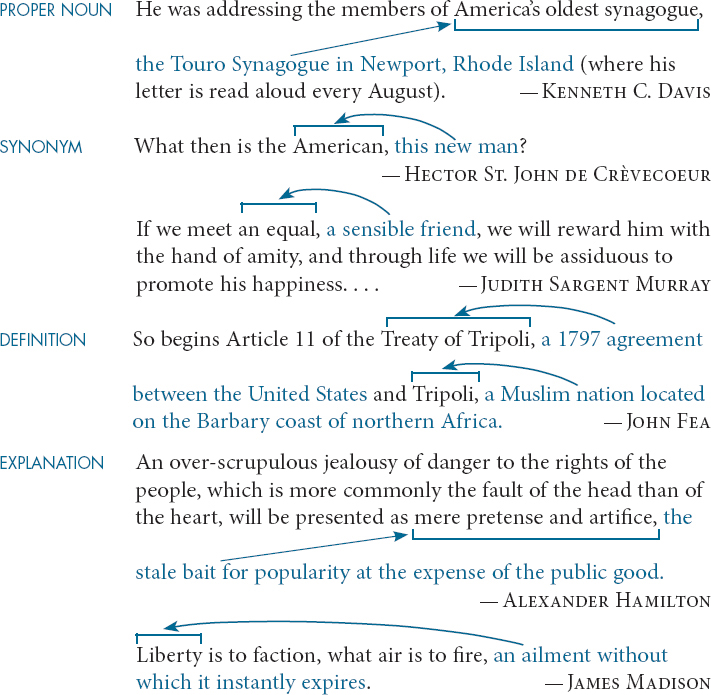GRAMMAR AS RHETORIC AND STYLE Appositives
Printed Pages 535-539An appositive is a noun or noun phrase that tells you more about a preceding noun, pronoun, or noun phrase. The appositive and the word or phrase to which it refers may be said to be in apposition. In each sentence below, the appositive is printed in blue. The arrow points to the noun, pronoun, or noun phrase to which the appositive refers.

—H. L. Mencken

—June Jordan

—Kenneth C. Davis

—Kenneth C. Davis
Punctuation and Appositives
Choosing Punctuation
The last example given does not use punctuation to set off the appositive from the rest of the sentence, but the others do. Here’s why: if the appositive is not essential to the meaning of the sentence but is more of an aside or a parenthetical remark (the technical term is nonrestrictive), then the writer uses punctuation to set it off. If the appositive is essential to the meaning of the sentence (restrictive), then the writer does not set it off with punctuation marks. Simply put, include what is essential; exclude what is not. In the first and second examples given above, the appositives for “essential traits and qualities of the male” and for “Phillis Wheatley” further identifiy each of them, but not in a way that is essential to the sentences, so H. L. Mencken and June Jordan set off the appositives with commas. In the final sentences, Kenneth C. Davis thought it essential that he tell the reader which future president he is writing about, so he does not punctuate the appositive.
If your appositive needs punctuation, you can set it off in one of three ways. First, you can use one or two commas.

—Jeff Jacoby
Second, you can use one or two dashes.

—John Fea
Third, you can use a colon.

—Jeff Jacoby
Dashes emphasize the appositive more than commas do. Furthermore, if an appositive contains its own internal commas, then one dash, two dashes, or a colon makes it easier to read the complete sentence.
Position of Appositive: Before or After a Proper Noun?
All the examples so far in this lesson have shown an appositive coming after the proper noun or pronoun it details. Proper nouns in apposition usually come first, with the appositive following.

—Phillis Wheatley
The proper noun may also follow, depending on the writer’s choice.

—Phillis Wheatley

—Benjamin Franklin
Whether you put the appositive before or after the noun it details is a stylistic choice. If in doubt, read the sentence aloud with several surrounding sentences to determine which placement sounds better. Of course, sometimes a writer may alternate placement in a sentence.
Rhetorical and Stylistic Strategy
Appositives generally serve two rhetorical and stylistic functions:
- First, an appositive can clarify a term by providing a proper noun or a synonym for the term, by defining or explaining the term, or by getting more specific.


- Second, an appositive can smooth choppy writing. Note how stilted and wooden the sentences below sound without appositives.
| NO APPOSITIVE | The most famous dissidents within the Puritan community were Roger Williams and Anne Hutchinson. They were banished following disagreements over theology and policy. |
| APPOSITIVE | The most famous dissidents within the Puritan community, Roger Williams and Anne Hutchinson, were banished following disagreements over theology and policy. —Kenneth C. Davis |
| NO APPOSITIVE | Philadelphia is the City of Brotherly Love. In that city, anti-Catholic sentiment, combined with the country’s anti-immigrant mood, fueled the Bible Riots of 1844, in which houses were torched, two Catholic churches were destroyed, and at least twenty people were killed. |
| APPOSITIVE | In Philadelphia, the City of Brotherly Love, anti-Catholic sentiment, combined with the country’s anti-immigrant mood, fueled the Bible Riots of 1844, in which houses were torched, two Catholic churches were destroyed, and at least twenty people were killed. —Kenneth C. Davis |
| NO APPOSITIVE | James Madison was a future president. He stepped into the breach. |
| APPOSITIVE | Future President James Madison stepped into the breach. —Kenneth C. Davis |
Sometimes a sentence will contain a double appositive; that is, there will be an appositive for an earlier appositive.

—H. L. Mencken
Notice that W. L. George is in apposition with “the Franco Englishman,” providing his name; then the noun phrase “one of the most sharp-witted of the faculty” further describes him in another appositive. Be on the lookout for a few examples like this one as you work through the exercises.